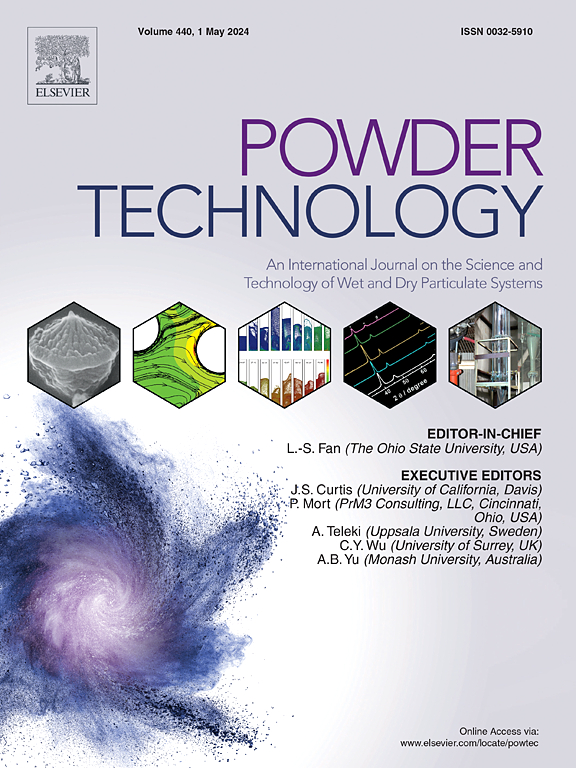AI-assisted prediction of particle impact deformation simulated by Material Point Method
IF 4.5
2区 工程技术
Q2 ENGINEERING, CHEMICAL
引用次数: 0
Abstract
A hybrid AI framework has been adopted to link the impact deformation of elastic-perfectly plastic particles with their material properties and impact velocity. Initially, Material Point Method (MPM) is employed to simulate the impact of an elastic-perfectly plastic particle with a rigid wall, covering an extensive range of material properties and impact velocities. The simulation results are then integrated into the AI framework to establish the relationship between the input and output parameters. Consequently, dimensionless equations are derived to predict the equivalent plastic strain and deformation extent based on the material properties and impact velocity of the particle, showing a strong agreement with the MPM results. The identified equations reveal that both the equivalent plastic strain and deformation extent depend on and can be determined from the yield strength of the material as well as the fraction of the incident kinetic energy that is spent on inducing plastic deformation. The validity of the equations is verified by comparing the MPM and predicted values of the equivalent plastic strain and deformation extent for cases with material properties and impact velocities beyond the initial dataset used for developing the equations. The equation identified by the framework for prediction of the deformation extent is further validated by impact experiments. Additionally, a correlation is suggested to estimate the coefficient of restitution based on the material properties, covering a wide range.

人工智能辅助预测材料点法模拟的颗粒冲击变形
采用混合AI框架将弹塑性颗粒的冲击变形与其材料特性和冲击速度联系起来。首先,材料点法(Material Point Method, MPM)用于模拟具有刚性壁的弹塑性颗粒的冲击,涵盖了广泛的材料特性和冲击速度。然后将仿真结果集成到AI框架中,以建立输入和输出参数之间的关系。在此基础上,导出了基于材料特性和颗粒冲击速度的等效塑性应变和变形程度的无因次方程,与MPM结果吻合较好。识别的方程表明,等效塑性应变和变形程度取决于并可以由材料的屈服强度以及用于诱导塑性变形的入射动能的比例来确定。通过比较材料性能和冲击速度超出用于建立方程的初始数据集的情况下的MPM和等效塑性应变和变形程度的预测值,验证了方程的有效性。通过冲击试验进一步验证了框架识别的变形程度预测方程。此外,还提出了一种基于材料特性的相关系数估计方法,适用范围较广。
本文章由计算机程序翻译,如有差异,请以英文原文为准。
求助全文
约1分钟内获得全文
求助全文
来源期刊

Powder Technology
工程技术-工程:化工
CiteScore
9.90
自引率
15.40%
发文量
1047
审稿时长
46 days
期刊介绍:
Powder Technology is an International Journal on the Science and Technology of Wet and Dry Particulate Systems. Powder Technology publishes papers on all aspects of the formation of particles and their characterisation and on the study of systems containing particulate solids. No limitation is imposed on the size of the particles, which may range from nanometre scale, as in pigments or aerosols, to that of mined or quarried materials. The following list of topics is not intended to be comprehensive, but rather to indicate typical subjects which fall within the scope of the journal's interests:
Formation and synthesis of particles by precipitation and other methods.
Modification of particles by agglomeration, coating, comminution and attrition.
Characterisation of the size, shape, surface area, pore structure and strength of particles and agglomerates (including the origins and effects of inter particle forces).
Packing, failure, flow and permeability of assemblies of particles.
Particle-particle interactions and suspension rheology.
Handling and processing operations such as slurry flow, fluidization, pneumatic conveying.
Interactions between particles and their environment, including delivery of particulate products to the body.
Applications of particle technology in production of pharmaceuticals, chemicals, foods, pigments, structural, and functional materials and in environmental and energy related matters.
For materials-oriented contributions we are looking for articles revealing the effect of particle/powder characteristics (size, morphology and composition, in that order) on material performance or functionality and, ideally, comparison to any industrial standard.
 求助内容:
求助内容: 应助结果提醒方式:
应助结果提醒方式:


